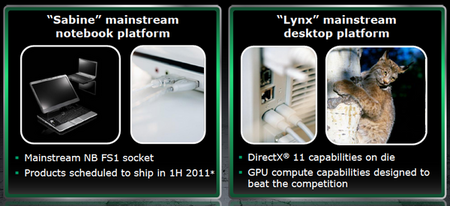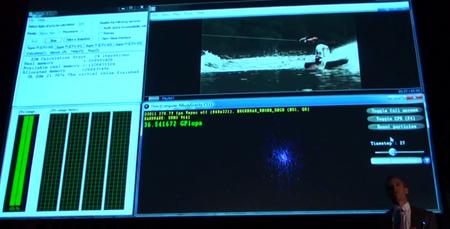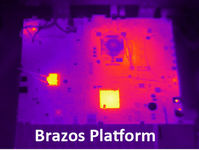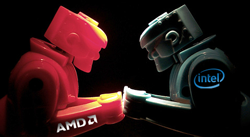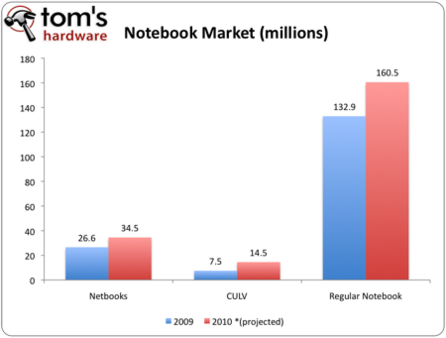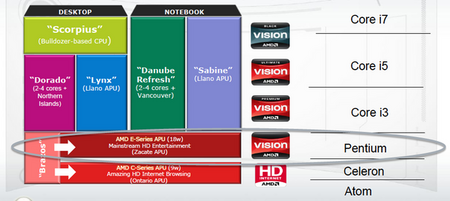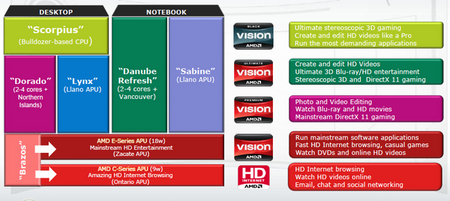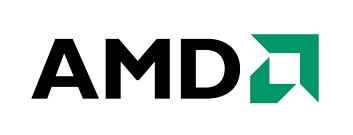
|
TopNax |
|
Home Previous AMD page Intel page Next |
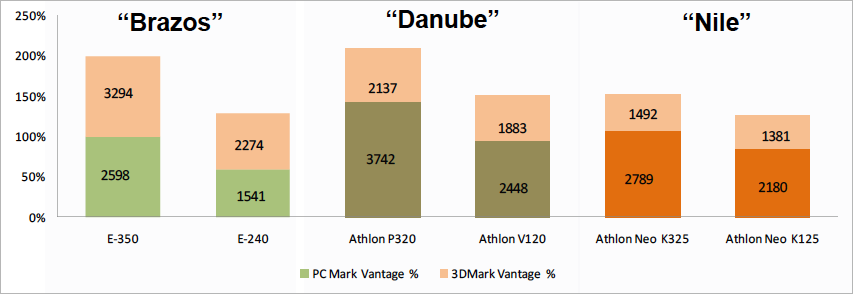
|
Based on AMD’s internal numbers, we've been told to expect CPU performance similar to what we saw on this year’s Nile platforms, with a substantial increase in 3D performance (naturally). |
|
The power management figures are a bit more interesting, falling within our expectations. Ontario doesn't seem to have as low of a minimum power state as the single-core Atoms, but keep in mind it is delivering a more compelling compute solution with close to Radeon HD 5400-class graphics. Given the ability to provide a more enriching video experience, the apples-to-apples battery life comparison may not hold up, as users feel less encumbered by a netbook platform.
Zacate is perhaps the more interesting of the two solutions (for us performance fanatics), given that it is supposed to compete against Intel's CULV (Pentium, Core 2, and Core 2 Duo) solutions often found in thin and light notebooks. Because of the limited room for add-in graphics, we often see the GMA 4500MHD on these systems. This is more than enough to watch Flash-based video (Hulu) and most high bit rate HD video, but it barely edges by in mainstream games like World of Warcraft. AMD's Zacate, meanwhile, is expected to provide comparable CPU performance with 5400-class graphics bite at a fraction of the power consumption. If AMD is can back up its claims, this is really going to be a boon for the thin and light form factor.
Code Name Cheat Sheet Updates
We spent the better part of a weekend rooting around in one of AMD’s beta Catalyst drivers provided to us by one of the company’s tech partners and calling up a few of our sources. For those that just love to get bubbly over code names...
Vancouver is AMD’s code name for the Mobility Radeon HD 6000-series. According to our sources, we only know of one specific discrete mobile GPU being readied for Q1’2011. More Mobility Radeon HD GPUs are no doubt on the horizon.
Wrestler is AMD’s code name for the GPU portion of an APU powered by a Bobcat core, so this includes the Ontario and Zacate APUs. There will be two graphic solutions: Radeon HD 6310 (Zacate) and Radeon HD 6250 (Ontario). The clock and memory speeds for the Radeon HD 6310 on the Zacate APUs are the same. This goes likewise for the 6250 on both Ontario APUs.
Sumo is AMD’s code name for the GPU portion of an Llano APU. Remember that Lynx is the mainstream desktop platform, while Sabine is the mainstream notebook platform. Both of these should come in dual, triple, and quad-core variants similar to the current Athlon II.
We've already seen a quad core Sabine. AMD actually demoed it at the TFE 2010 event and at the recent Radeon launch. Based on our sources, there should be six Llano APUs released in 2011. Three of these will be APUs for Sabine and the other three will be for Lynx. All Llanos will share the GPU core at the architectural level, most likely based on Redwood.
Remember that Sabine and Lynx are platform names, just like Brazos. A platform is defined as a CPU (APU in the case of Fusion) plus a chipset. Given what we have seen with Brazos, Sabine and Lynx are each likely to have their own southbridge or a different generational version of the same southbridge.
On a side note, in AMD's vein of using half a proper noun (Sumo Wrestler) for a code name, we have a few suggestions for future APUs. If we continuing with the whole Japanese motiff, why not "Miso" & "Soup"? Or if AMD just wants some thing along the aggressive vein, how about "Bowie" & "Knife". Jim Bowie took no prisoners and was flat out an awesome Texan to boot, so it would go well with the whole Llano tribute... |
Impressions And Implications |
|
Impressions: Performance A few days ago, AMD invited a few people to take a peek into the performance of a Brazos notebook. |
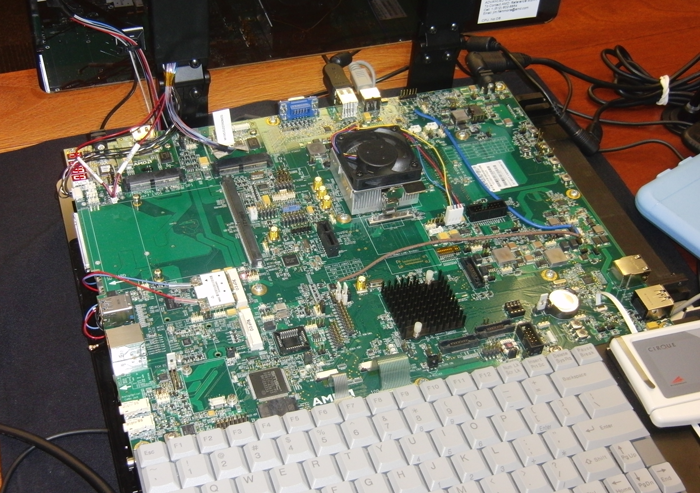
|
Keep in mind that we previewed the E-350, which happens to be the dual-core version of Zacate. |
|
Performance is just about what we expected, though we won't be able to go into more depth until next week. As far as the CPU performance is concerned, the E-350 fits in similarly with what we've seen on the midrange Nile systems (K335/K125). As far as 3D performance, it approaches what AMD has already presented from a desktop Radeon HD 5400, which makes a lot of sense given that it shares architectural cues with the Cedar core. AMD is holding everyone from releasing the actual numbers for roughly another week, so stay tuned. You could already play games like World of War craft on the Nile platform. The difference is that now you can also play DiRT 2 using entry-level settings. Impressions: Power Consumption & Heat The numbers we got a for the E-350 platform are very impressive considering that it falls somewhere between a premium netbook configuration and a thin and light with desktop graphics. |

|
bviously, AMD prefers not to make a comparison direct comparison to Atom. But we believe that some of the dual-core Atom configurations are fair game, given the market price range--$399 to $599. We'll report back more information next week, but we have these teaser images using a very expensive T400 camera generously provided by FLIR. Keep in mind that we did not maintain the same thermal scale on these two pictures, but we will in part two of our preview.
Implications What does all of this mean for the AMD and Intel battle? Well, what wasn't a particularly competitive marketplace before is suddenly a lot more interesting. Does Intel have something to worry about? It's too early to tell, but AMD is all but betting its future on the fact that it can usurp the chip giant. The biggest criticism leveled against Intel time and time again is poor graphics performance. This is the reason AMD and Nvidia have the market share numbers that they do. Intel was still able to maintain a strong hold on the market because it provided OEMs a single source of hardware with a lower power profile. By the looks of Zacate, AMD is getting its house in order to cut down every advantage Intel has leisurely enjoyed. Six months back, AMD was only missing two major system vendors from its mobile processor portfolio: Sony and Apple. As of late, AMD has achieved Sony design wins, so that really just leaves one holdout, which would be the ultimate feather in AMD's cap. Based on what we have seen with Zacate, Fusion APUs gives AMD a better-than-fighting chance to win over that last "missing vendor," given Apple's preference for low power consumption. |
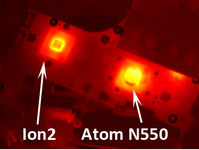
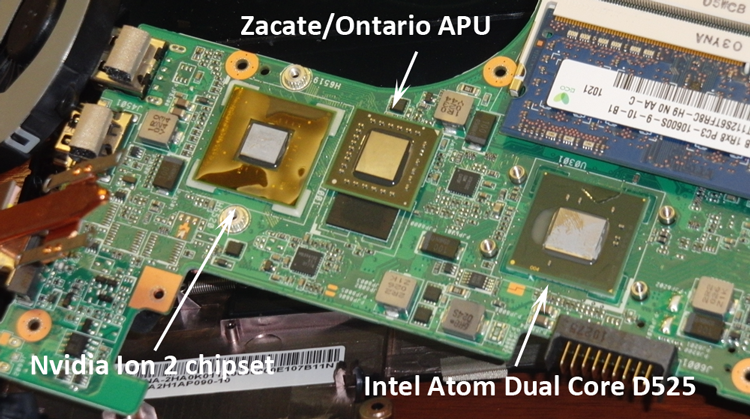
|
Zacate is an impressive work of engineering. To put it in perspective, think of fitting Nvidia's Ion 2 graphic core into Intel's dual core Atom die, while using less silicon and shrinking the package size. To do all of that and offer competitive performance is a challenge. If AMD can also add a lower price into the mix, it'll have the makings of pure win.
Thin and light notebooks, budget all-in-one desktops, and premium netbooks are all within Zacate's target range of $500. Given the volume on budget netbooks and desktop replacements, we're not sure how many Zacate chips will actually sell. It is a competitive solution, but the majority of laptop sales are elsewhere. In fact, if you remove netbooks from the equation, 15" notebooks, which we consider to be desktop replacements, account for close to 50% of all notebook sales. The other 50% can be split up between 14" and 17" notebooks. This means for AMD to really hit a home run, we need to see how far Sabine has come along.
Looking toward the future, AMD may have the "right stuff" to change the dynamics of notebook sales. Earlier in the year, an iSuppli report projected that the largest growth opportunity for notebooks was in the Consumer Ultra Low Voltage (CULV) notebook. If it turns out that Intel cannot outperform these upcoming offerings, AMD's market share victory may prove as lopsided as Intel's current grasp of the server market. At the moment, the Arrandale ULV parts rank in with a TDP of 18 W across the board. Hopefully, the mobile Llanos for the Sabine platform don't push TDP figures too far beyond Zacate's 18 W. Those mobile Arrandales, like the Core i7-660UM, carry some serious punch in the CPU department and will spank Zacate. In the short term, AMD is going to need to convince system builders that good graphics performance is better than having an overabundance of processor horsepower.
Inevitably, AMD still needs to find ways to engage the brick and mortar (B&M) customer that walks in to a Best Buy. That was the reason behind the conception of the Vision campaign, and it is something it need to keep its eyes on (I still can't see Vision being as successful as Centrino was). For those of us who can compare clock speeds, cache sizes, and core architectures, the buying decision is a more evaluative process. However, AMD's success depends as much on customers who nit pick about performance (and influence the purchases of friends and family) as those who don't. AMD in some ways still carries this stigma of too much power, too much heat. It's also still finding that it needs to shake off the reputation of being Intel-alternative versus simply standing on its own merits. AMD Fusion has all the indicators of being able to breathe new life into the company's performance portfolio. What is left is how the company handles its newfound weapon. |
|
Home Previous AMD page Intel page Next |
|
Battery Life (55 Wh battery) |
Hours (claims) |
|
Ontario (netbook) |
10-11 |
|
Zacate (thin and light) |
8-9 |
|
Single Core Atom (netbook) |
10 |
|
Dual Core Atom (netbook) |
8-9 |
|
Core 2 Duo (thin and light) |
6-7 |
|
Platform Specifications |
|
|
CPU |
AMD E-350 (Zacate) |
|
Memory |
4 GB DDR3-1066 |
|
Motherboard |
AMD Engineering Sample |
|
Graphics |
AMD Radeon HD 6310 DX11 Graphics (Wrestler) |
|
Hard Drive |
128 GB Crucial SSD |
|
OS/Software |
Windows 7 Ultimate x64 |
